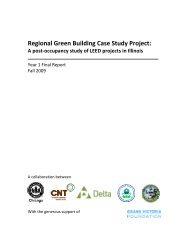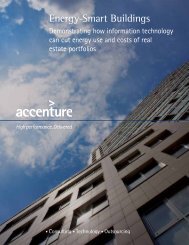CEA 2010 Sustainability Report - Consumer Electronics Association
CEA 2010 Sustainability Report - Consumer Electronics Association
CEA 2010 Sustainability Report - Consumer Electronics Association
You also want an ePaper? Increase the reach of your titles
YUMPU automatically turns print PDFs into web optimized ePapers that Google loves.
Sony ‘LEEDs’ the Way<br />
Sony <strong>Electronics</strong> Inc. designed and constructed<br />
a new U.S. head office building in San Diego,<br />
Calif., which was awarded Leadership in Environmental<br />
Design (LEED ® ) Gold certification from<br />
the U.S. Green Building Council Institute. The<br />
building’s design integrates a number of green<br />
elements including bicycle racks and dedicated<br />
parking spaces for staff who carpool to work<br />
or drive fuel-efficient vehicles. In addition, 75<br />
percent of the wood used in framing, flooring<br />
and furniture is certified by the Forest Stewardship<br />
Council as coming from a sustainably<br />
managed forest.<br />
The company also implemented a number<br />
of water saving measures, including a system<br />
that re-routes water discharged by the<br />
air-conditioning system to a fountain in the<br />
atrium, and motion sensors for the toilets<br />
that flush a small amount of water when the<br />
user moves. These efforts are expected to<br />
reduce the consumption of water by 47<br />
percent compared to conventional buildings.<br />
Sony also designed its headquarters to maximize<br />
energy performance by 22 percent by<br />
installing automatic light sensors, variable<br />
speed drives for A/C units and optimizing the<br />
use of daylight as 75 percent of the facility’s<br />
square footage receives natural daylight. This<br />
building was conceived as part of broader<br />
commitment by Sony to achieve zero<br />
environmental footprint by 2050 with a<br />
program known as the Road to Zero.<br />
E N V I RO N M E NTA L<br />
PERFORMANCE<br />
SUSTAINABLE<br />
PRODUCT DESIGN<br />
SUSTAINABLE<br />
PACKAGING DESIGN<br />
SUSTAINABLE<br />
FACILITIES<br />
SUSTAINABLE<br />
TRANSPORT<br />
& DELIVERY<br />
ENERGY<br />
EFFICIENCY<br />
ECYCLING<br />
SOCIAL<br />
PERFORMANCE<br />
SOCIAL<br />
CONTRIBUTIONS<br />
CORPORATE<br />
SUSTAINABILITY<br />
REPORTING<br />
Reducing Energy Consumption<br />
and Greenhouse Gas Emissions<br />
As society takes action to mitigate the impacts<br />
associated with climate change, the CE industry<br />
faces a challenge. It must continue to meet<br />
the world’s growing demands for consumer<br />
electronics while simultaneously reducing<br />
operational energy consumption and<br />
associated greenhouse gas (GHG) emissions.<br />
Many CE companies have begun to track their<br />
energy consumption, calculate their organizational<br />
carbon footprints, and publicly report the findings<br />
in annual corporate sustainability reports and/<br />
or through GHG reporting programs such as the<br />
Carbon Disclosure Project (CDP). Launched in<br />
2000, CDP seeks to accelerate solutions to climate<br />
change by harmonizing climate change data<br />
from organizations around the world and developing<br />
international carbon reporting standards.<br />
The data reported by companies is then made<br />
available for use by a wide audience including<br />
institutional investors, corporations, policymakers<br />
and their advisors, public sector organizations,<br />
government bodies, academics and the public.<br />
CE A <strong>2010</strong><br />
SUSTAINABILIT Y<br />
REPORT<br />
21















